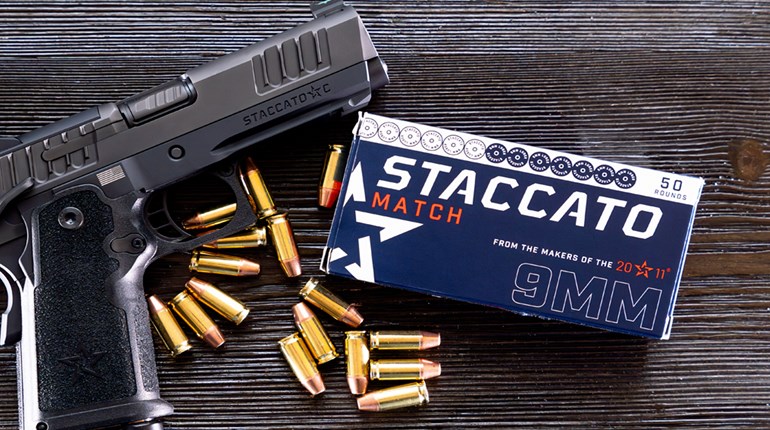
Recently we’ve seen numerous attempts to modernize defensive-handgun ammunition with radically designed bullets. Two of the first companies attempting this were Extreme Shock—now Allegiance Ammunition—out of Clintwood, VA, and Missouri-based Dynamic Research Technologies (DRT). Both used an intensely compressed-metal-particle bullet, held together with a proprietary binder, inside a copper jacket. I visited both companies, talked with their engineers and conducted my own tests.
I was recently invited to visit the Polycase ammunition company in Savannah, GA. The company manufacturers a copper-particle bullet held together with a proprietary binder, but unlike the bullets of Extreme Shock and DRT, the Polycase bullet is more of an injection-molded projectile. I was unable to attend, but it wasn’t long before several cases of ammo showed up for my experimenting pleasure.
I exposed this ammo to the usual inspections and, unashamedly, shot every last round. The reason I mention the other manufacturers is threefold. First, I reported my test results for those munitions within this column in December 2007 and October 2009, respectively. Second, all three companies offer bullets that depart from the traditional copper/gilding-metal jacket and lead or lead-alloy core configuration. And finally, with regard to whether the new Polycase ammo works or not, I’m left with the same speculation I was with Extreme Shock and DRT.
I’ll explain, but first we must define what “works” means with regard to defensive-handgun ammo. The primary objective of any defensive handgun load is to offer 100 percent reliability in your handgun. Secondly, it needs to be accurate enough to strike to point-of-aim. Finally, it should penetrate deep enough and cause enough damage to bring about an immediate and prolonged cease-and-desist order, directed to the bad person or bad critter trying to do you harm.
Establishing the first two criteria is relatively easy; you shoot lots of the ammo in assorted firearms and see if you can hit what you’re aiming at. As far as the third goes, we’re left with mostly speculation. To help us with this conjecture, we shoot bullets into 10-percent ordnance gelatin or other messy substances, meticulously measure and examine the results, then form a hypothesis (that’s a fancy word for a guess) about what would happen if the gel block had been attacking us when we shot it.
The Polycase Inceptor ARX bullets are light-for-caliber—on average they’ll weigh about60 percent of their conventional counterparts. This means recoil can be as much as 35 percent less. Recoil is another, albeit less-important, consideration. Less recoil translates to faster recovery and follow-up shots. Surprisingly, the lighter bullets do not equate to a reduction in energy. To the contrary, their increased velocity balances the equation. Energy figures for ARX loads are similar to standard defensive offerings with projectiles weighing 40 percent more.

The real difference between Polycase ARX bullets and conventional defensive-handgun bullets is that the ARX bullets do not expand. They are intended to act as a solid projectile. But, the unique drill-bit profile uses, according to Polycase, “…fluid dynamics instead of expansion to achieve superior terminal performance.” Polycase contends that this bullet relies on the hydraulic displacement of fluids to match or exceed the tissue destruction caused by conventional bullets.
As advertised by Polycase, the ARX bullet assumes a controlled, tumbling path through soft tissue that leads to more tissue destruction than can be imparted by conventional non-expanding handgun projectiles. Polycase even suggests ARX terminal performance will equal or exceed that of common expanding handgun bullets. Tests in 10-percent ordnance gelatin verified the tumbling effect and the additional wounding beyond ordinary FMJ style bullets. The 74-grain 9 mm load averaged 18 inches of penetration. But, based on my testing, I’m not convinced ARX bullets can exceed the tissue damage of bullets like Federal HST, Remington Golden Saber, or Speer Gold Dot.
Polycase also claims when the ARX bullet, “…encounters tougher barriers it is designed to break up to reduce the risk for collateral damage due to overpenetration.” This can be beneficial, particularly when shooting steel on the practice range, but I was worried it might also mean the bullet would react the same way when impacting bone. After all, a shot to the thoracic cavity of a bad guy trying to slice you like a Christmas turkey has at least a 50-percent chance of hitting a rib.
To test this, I placed a section of raw pork ribs in front of blocks of 10-percent ordnance gelatin. Using the 9 mm load, I shot through the ribs, intentionally hitting bone, to see how the bullet would react. This induced some break up of the ARX bullet, but it did not markedly reduce penetration. However, after striking the rib, the bullets struggled to maintain a straight path. I was unable to recover any of the bullets shot through ribs because they all exited the sides of the gel blocks.
Polycase ARX ammo is very reliable: I had no stoppages while firing more than 2,000 rounds, through six different handguns, chambered for four different cartridges. It also proved just as accurate as conventional ammunition. It’s my contention ARX loads would be a viable defensive option if I was limited to non-expanding projectiles, if recoil were an issue and/or if you were concerned about penetrating hard barriers. I cannot confirm if it’s as effective at stopping bad guys. As hard as I tried, I could not assemble a large enough sampling of folks—good or bad—who were willing to let me shoot them to find out for sure.






































